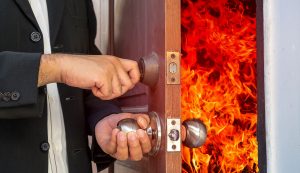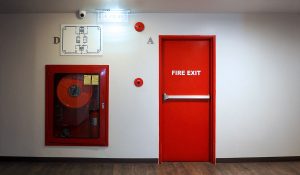Fire doors are an integral part of a building’s passive fire protection system, designed to save lives and minimise property damage in the event of a fire. In the UK, strict legal requirements govern the installation, maintenance, and use of fire doors to ensure they perform their intended function effectively. Understanding these regulations is essential for property owners, building managers, and anyone responsible for fire safety compliance. This guide outlines the key legal requirements for fire doors in the UK and provides practical advice to help you meet your obligations.
The Role of Fire Doors in Fire Safety
Before delving into the legal requirements, it’s important to understand the critical role fire doors play in fire safety. Fire doors are designed to:
- Contain Fire and Smoke: By compartmentalising areas of a building, fire doors slow the spread of fire and smoke, giving occupants more time to evacuate.
- Protect Escape Routes: They help maintain clear and safe pathways for people to exit the building.
- Enable Firefighting Efforts: Containing the fire makes it easier for firefighters to access and control the blaze.
To achieve these objectives, fire doors must meet stringent design and installation standards.
Key Legislation Governing Fire Doors in the UK
The primary legal frameworks that regulate fire doors in the UK are:
1. The Regulatory Reform (Fire Safety) Order 2005 (RRO)
The RRO applies to all non-domestic premises and places responsibility for fire safety squarely on the “Responsible Person.” This could be the building owner, employer, or manager. Under the RRO, fire doors must:
- Be installed where required by a fire risk assessment.
- Be maintained to ensure they remain fit for purpose.
- Meet British Standards and relevant fire safety regulations.
2. Building Regulations 2010
Part B of the Building Regulations covers fire safety in new and altered buildings. It specifies where fire doors are required and their fire resistance ratings, such as FD30 (30 minutes) or FD60 (60 minutes). Key considerations include:
- Fire doors must be used in areas that separate compartments, stairwells, and escape routes.
- Intumescent seals and self-closing devices are mandatory to ensure effectiveness.
3. The Housing Act 2004
This Act applies to rented properties, including Houses in Multiple Occupation (HMOs). It requires landlords to ensure fire safety measures, including compliant fire doors, are in place to protect tenants.
4. British Standards (BS 476 and BS EN 1634-1)
These standards outline the testing methods for fire doors, ensuring they can withstand fire and smoke for the specified duration. Fire doors must meet these standards to be legally compliant.
Where Fire Doors Are Required
Fire doors are legally required in specific areas of buildings to create effective fire compartmentation. Common locations include:
- Escape Routes: Corridors and stairwells used for evacuation.
- Compartments: Areas designed to contain fire, such as plant rooms or storage areas.
- Residential Properties: In flats, fire doors are often required between communal areas and individual units.
- Commercial Buildings: Offices, retail spaces, and factories must have fire doors separating high-risk areas from escape routes.
Fire Door Specifications and Compliance
To comply with UK regulations, fire doors must meet certain specifications:
1. Fire Resistance Ratings
Fire doors are classified based on how long they can resist fire. For example:
- FD30: 30 minutes of fire resistance.
- FD60: 60 minutes of fire resistance.
The rating required depends on the building’s use, layout, and fire safety strategy.
2. Certification Labels
Certified fire doors must carry a label or marking indicating their fire resistance rating and compliance with relevant standards. Missing or damaged labels can invalidate compliance.
3. Components
Fire doors must be equipped with:
- Intumescent Strips and Smoke Seals: These expand when exposed to heat, sealing gaps to prevent the spread of fire and smoke.
- Self-Closing Devices: Ensures the door automatically closes after being opened.
- Fire-Resistant Glazing: Any glass panels must meet fire resistance standards.
- Correct Hardware: Hinges, locks, and handles must also be fire-resistant.
Maintenance and Inspection Requirements
The law requires fire doors to be properly maintained to ensure they remain effective. Key maintenance obligations include:
1. Regular Inspections
Fire doors should be inspected every six months, with more frequent checks in high-traffic areas. Inspections should assess:
- Door alignment and closure.
- Condition of intumescent strips and seals.
- Integrity of the door leaf and frame.
- Functionality of hardware such as hinges and self-closing devices.
2. Repairs and Replacements
Damaged fire doors must be repaired or replaced promptly. This includes fixing issues like warped doors, worn seals, or broken hardware.
3. Record-Keeping
Records of inspections, maintenance, and repairs should be kept as proof of compliance. These may be required during fire safety audits.
Consequences of Non-Compliance
Failure to comply with fire door regulations can have serious consequences, including:
- Legal Penalties: Non-compliance can result in hefty fines or imprisonment for the Responsible Person.
- Increased Liability: In the event of a fire, non-compliance may lead to legal action from injured parties.
- Insurance Issues: Many insurers require proof of fire safety compliance. Failure to meet standards could invalidate claims.
- Risk to Lives and Property: The most serious consequence is the increased risk to occupants’ safety.
Practical Tips for Compliance
To ensure compliance with UK fire door regulations:
- Conduct a Fire Risk Assessment: Identify where fire doors are needed and ensure they meet the required standards.
- Install Certified Fire Doors: Work with a professional installer to ensure doors meet legal specifications.
- Schedule Regular Inspections: Keep up with maintenance to address wear and tear.
- Train Staff: Educate employees or building occupants on the importance of fire doors and how to use them correctly.
Conclusion
Fire doors are a legal and practical necessity for protecting lives and property in the UK. By understanding and adhering to the regulations outlined above, you can ensure your building remains safe and compliant. Regular inspections, proper maintenance, and working with certified professionals are key to meeting these obligations.
At Original Fire, we specialise in fire door installation, maintenance, and compliance. Contact us today to ensure your fire doors meet all legal requirements and provide the safety your building needs.



